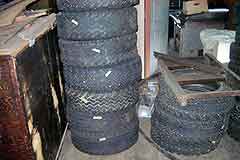Many motorists live in regions where two sets of tires are needed, snow tires and regular tires. This means one set has to be stored. Here are some tips to prevent the stored tires from being damaged while sitting idle.

The causes of tire deterioration are natural aging and oxidation as well as ultraviolet and ozone damage. Both heat and light cause oxidation indicated by crazed surfaces. While not deep, oxidation penetration can create enough damage to cause a slow leak or early tube failure. Ozone attacks rubber, casing it to crack perpendicular to any applied stress. When cracks are deep enough, they can penetrate and weaken the carcass. The cracks can also provide access to foreign material. One of the best ways to preserve tires is to drive the vehicle. That is why tires on most vehicles wear out before they deteriorate. Here oils in the tires come to the surface during flexing to protect the rubber from UV light and hardening.
Store tires in an area that is clean, cool, dry, dark and well ventilated with circulating air. It is better to store tires in a dry basement than outdoors or in a hot garage or attic. Basement temperatures tend to remain cooler and more stable, while outdoors, garages and attics can become hot and experience large temperature fluctuations. Store tires away from electrical devices such as motors, generators, furnaces, sump pumps and switches because these are sources of ozone.
Never leave tires on oily floors or otherwise in contact with solvents, oil or grease. These materials are readily absorbed into rubber and will weaken it. Incidentally, while tire dressings may make tires look great, but they can accelerate deterioration. Many foreign materials decrease the effectiveness of tire compounds that are formulated to resist ozone cracking or weather.
It is better to store tires vertically rather than stacking them horizontally. Storing vertically reduces stress and possible tire distortion. If you stack tires, place them on a clean wood foundation to protect them from dirt oil and grease. Then cover with a sheet of opaque or black polyethylene film to limit exposure to oxygen and ozone in the air. The best advice is to store each tire in its own large, opaque, airtight plastic bag. You can get them at tire stores or use lawn and garden bags. Tape the bag shut to prevent moisture from entering and remove as much air as practical. Horizontally stacked tires should be piled symmetrically and never stacked so high as to cause severe distortion in the bottom tires.
When stacking white letter tires, stack "white-to-white" and "black-to-black" to prevent staining the white rubber. Black rubber and white rubber are compounded differently. The tire's "white" side uses a top layer of non-staining black rubber over the white to prevent oils in the tire from migrating into the exposed white rubber and discoloring it. Stacking all tires white side up can let the oils from the black sidewall migrate into the white rubber.
Dirt and water themselves won't harm mounted tires, but both can cause problems if left inside un-mounted tires. Tires should be stored so there is no danger of water collecting inside. Besides causing damaging, moisture can be a breeding ground for mosquitoes and other insects. Allow air to circulate around all sides of the tires, including underneath, to prevent moisture damage. Water left inside a tire can be turned into damaging steam as casing heat builds up at highway speeds.
Before that first trip, carefully inspect the tires. Check both sidewalls and tread area as well as the condition of valve stems, valve caps and wheels. The tread and casing should be checked for any unusual wear, cracking, penetrations or cuts. If tires show cracking in the sidewall or tread surfaces that are more than 2/32nds deep, they should be replaced.
Any tire that is over five years old should be carefully inspected for cracking and replaced, even if it has acceptable thread left. To determine the age of a tire, look at the DOT number on the sidewall, which identifies the manufacturer, plant where the tire was built, the type of construction, and the date of manufacture. For example, the number 245 (i.e. DOT8ST46245) indicates the tire was manufactured in the 24th week of 1985 or 1995. A triangle symbol denotes the decade -- that is the 80s or 90s. More recent tires use a four number code, for instance, 3401 or the 34th week of 2001.
Mounted tires in storage should be maintained at no less than 10 psi. Always check air pressure after storage using an accurate tire gauge. Pressure should be checked on cold tires, meaning a vehicle not driven more than about a mile. Do not reduce pressure when a tire is hot or exceed the maximum cold pressure.




